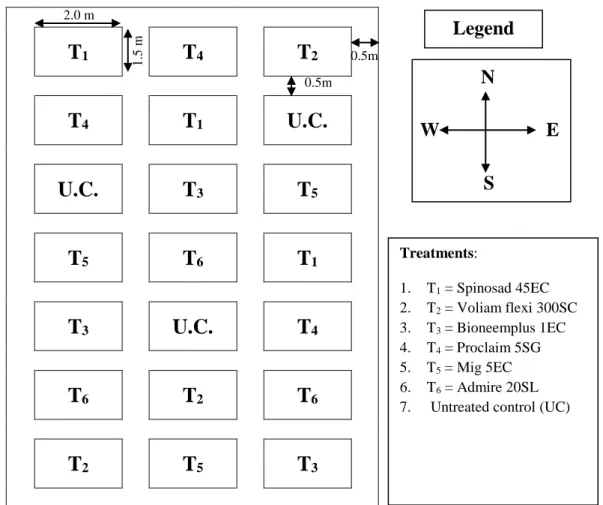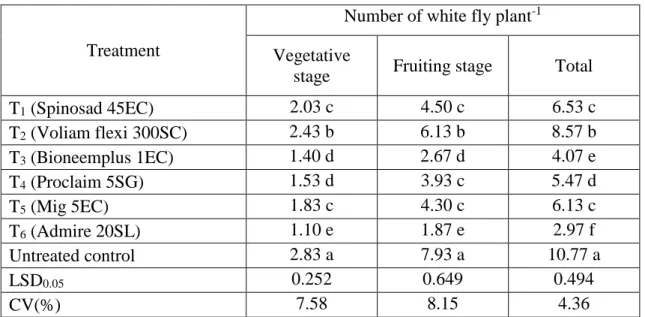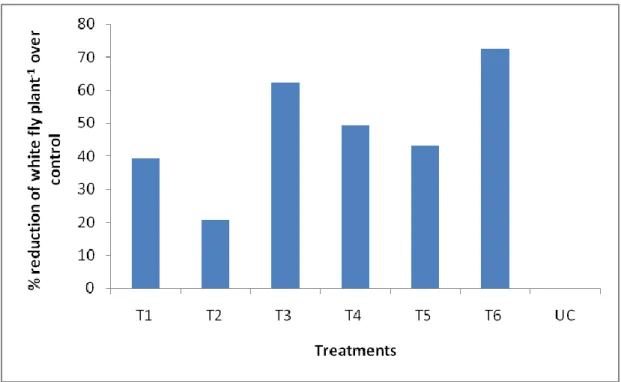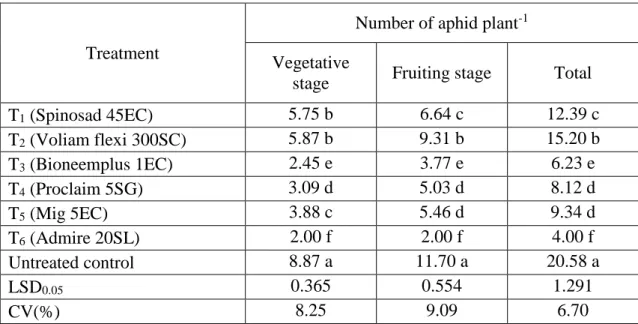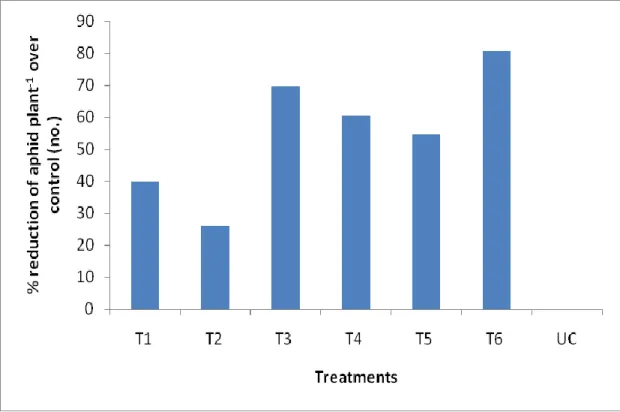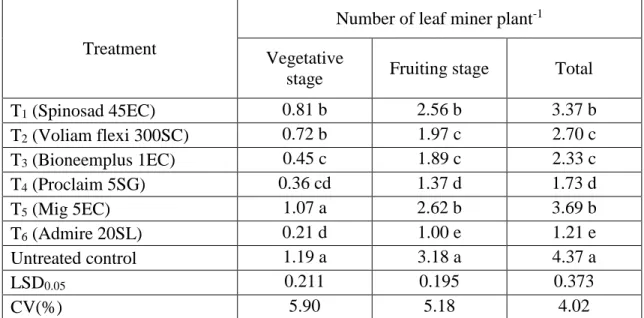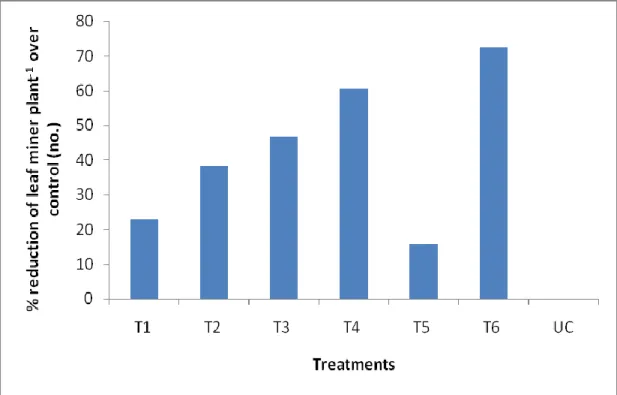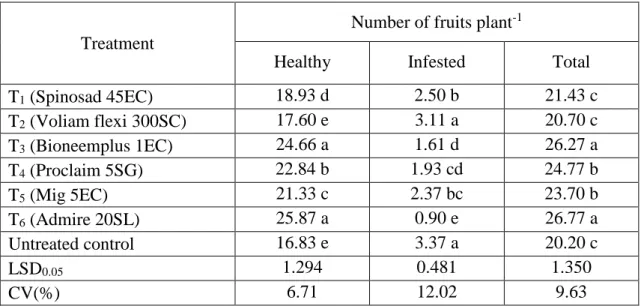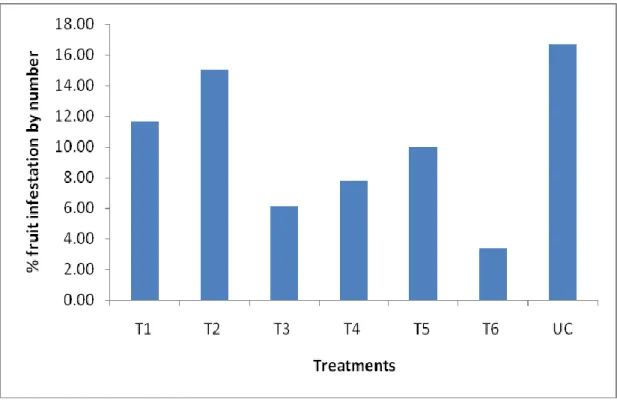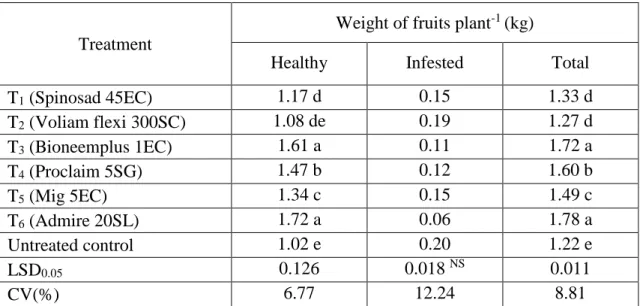i
EFFECT OF SOME SELECTED INSECTICIDES AND BOTANICALS AGAINST INSECT PESTS FOR
YIELD AND SEED QUALITY OF TOMATO
NOWSHER AHMED MOON
INSTITUTE OF SEED TECHNOLOGY
SHER-E-BANGLA AGRICULTURAL UNIVERSITY DHAKA -1207
JUNE 2021
ii
EFFECT OF SOME SELECTED INSECTICIDES AND BOTANICALS AGAINST INSECT PESTS FOR
YIELD AND SEED QUALITY OF TOMATO BY
NOWSHER AHMED MOON REGISTRATION NO. : 13-05453
A Thesis
Submitted to the Institute of Seed Technology Sher-e-Bangla Agricultural University, Dhaka
partial fulfillment of the requirements for the degree of
MASTER OF SCIENCE (M.S.) IN
SEED TECHNOLOGY
SEMESTER: JANUARY- JUNE, 2019 Approved by:
Prof. Dr. Ayesha Akter Department of Entomology
SAU, Dhaka Supervisor
Prof. Dr. Md. Ismail Hossain Department of Horticulture
SAU, Dhaka Co-Supervisor
Prof. Dr. Md. Ismail Hossain Chairman
Examination Committee
&
Director
Institute of Seed Technology
iii
INSTITUTE SEED TECHNOLOGY Sher-e-Bangla Agricultural University
Sher-e-Bangla Nagar, Dhaka-1207
CERTIFICATE
This is to certify that the thesis entitled “EFFECT OF SOME SELECTED INSECTICIDES AND BOTANICALS AGAINST INSECT PESTS FOR YIELD AND SEED QUALITY OF TOMATO” submitted to the INSTITUTE OF SEED TECHNOLOGY, Faculty of Agriculture, Sher-e-Bangla Agricultural University, Dhaka, in partial fulfillment of the requirements for the degree of MASTERS OF SCIENCE (M.S.) in SEED TECHNOLOGY, embodies the result of a piece of bonafide research work carried out by NOWSHER AHMED MOON, Registration No. 13-05453 under my supervision and guidance.
No part of the thesis has been submitted for any other degree or diploma.
I further certify that any help or source of information, received during the course of this investigation has been duly acknowledged.
June 2021
Dhaka, Bangladesh
Prof. Dr. Ayesha Akter Department of Entomology
SAU, Dhaka Supervisor
iv
DEDICATED TO
ALL MY TEACHERS
i
ACKNOWLEDGEMENTS
The author seems it a much privilege to express his enormous sense of gratitude to the Almighty Allah for His ever ending blessings for the successful completion of the research work.
The author wishes to express his gratitude and best regards to his respected Supervisor, Prof. Dr. Ayesha Akter, Department of Entomology, Sher-e-Bangla Agricultural University, Dhaka, for her continuous direction, constructive criticism, encouragement and valuable suggestions in carrying out the research work and preparation of this thesis.
The author wishes to express his earnest respect, sincere appreciation and enormous indebtedness to his reverend Co-supervisor, Prof. Dr. Md. Ismail Hossain, Department of Horticulture, Sher-e-Bangla Agricultural University, Dhaka, for his scholastic supervision, helpful commentary and unvarying inspiration throughout the research work and preparation of the thesis.
The author further feels to express his heartfelt thanks to the Director, Prof. Dr.
Ismail Hossain, Institute of Seed Technology along with all other teachers and staff members, Sher-e-Bangla Agricultural University, Dhaka, for their co-operation during the period of the study.
The author feels proud to express his deepest and endless gratitude to all of his course mates and friends specially Kazi Mohammad Rabbi,Sourav Saha to cooperate and help him during taking data from the field and preparation of the thesis.
The author expresses his heartfelt thanks to his beloved parents,Elder Brother, Reverend Aunt(Khala) and all other family members for their prayers, encouragement, constant inspiration and moral support for his higher study. May Almighty bless and protect them all.
The Author
ii
EFFECT OF SOME SELECTED INSECTICIDES AND BOTANICALS AGAINST INSECT PESTS FOR
YIELD AND SEED QUALITY OF TOMATO
ABSTRACT
The present experiment was conducted to study the effect of some selected insecticides and botanicals against insect pests for yield and seed quality of tomato at the farm of Shcr-e-Bangla Agricultural University, Dhaka during the period from October 2019 to March 2020. The experiment consisted of 7 treatments viz,T1 = Spinosad 45EC @ 0.4 ml/L of water, T2 = Voliam flexi 300SC @ 0.5 ml/L of water, T3 = Bioneemplus 1EC @ 0.5 ml/L of water, T4 = Proclaim 5SG @ 1.0 g/L of water, T5 = Mig 5EC @ 1.0 ml/L of water, T6 = Admire 20SL @ 0.5 ml/L of water and Untreated control, applied at 7 days interval through out the cropping season. The experiment was laid out in Randomized Complete Block Design with three replications. Among different treatments, T6 (Admire 20SL) showed the best performance on the incidence of whitefly, aphid and leaf miner plant-1 and showed lowest number (2.97, 4.00 and 1.21, respectively) and gave 72.45%, 80.55% and 72.26% reduction of incidence over control, respectively and regarding borer infestation of tomato, this treatment also showed highest healthy fruit plant-1 by number (25.87) and weight (1.72 kg) compared to untreated control which showed least performance. Treatment T6 (Admire 20SL) also showed highest healthy fruit yield (86.18 t ha-1) and maximum 68.81% increase of healthy fruit yield over control while the lowest infested fruit yield (3.02 t ha-1) was obtained with this treatment which was followed by T3 (Bioneemplus 1EC) whereas untreated control gave lowest healthy and the highest infested fruit yield (51.05 and 10.18 t ha-1, respectively).The yield contributing parameters and seed yield of tomato, treatment T6 (Admire 20SL) performed the highest plant height (94.29 cm), number of branches plant-1 (11.25), number of flower clusters plant-1 (8.63), number of fruits cluster-1 (6.37), single fruit weight (66.64 g), seed weight fruit-1 (0.57 g), seed weight plant-1 (12.73 g) and seed yield (636.70 kg ha-1) whereas untreated control treatment showed poorest performance.In case of seed quality parameters, treatment T3 (Bioneemplus 1EC) treated plot showed the highest seed germination (97.23%), root length (3.41 cm), shoot length (5.25 cm) and seed vigor index (842.70) followed by T6 (Admire 20SL) whereas untreated control plot showed the lowest results (83.80%, 1.91 cm, 3.75 cm and 473.70, respectively). From the above result, it may be concluded that the treatment T6 (Admire 20SL) showed the best performance in suppressing whitefly, aphid and leaf miner plant-1 which resulted higher healthy fruit yield and seed yield followed by T3 (Bioneemplus 1EC). In case of seed quality parameters, T3
(Bioneemplus 1EC) showed best performance while T6 (Admire 20SL) showed comparatively better performance.
iii
LIST OF CONTENTS
Chapter Title Page
No.
ACKNOWLEDGEMENTS i
ABSTRACT ii
LIST OF CONTENTS iii
LIST OF TABLES v
LIST OF FIGURES vi
LIST OF PLATES vii
LIST OF APPENDICES viii
ABBREVIATIONS AND ACRONYMS ix
I INTRODUCTION 1-4
II REVIEW OF LITERATURE 5-35
III MATERIALS AND METHODS 36-46
3.1 Experimental location 36
3.2 Climate 36
3.3 Soil 36
3.4 Test crop 37
3.5 Treatments 37
3.6 Variety used and seed collection 37
3.7 Raising of seedlings 37
3.8 Experimental design and layout 38
3.9 Preparation of the main field 39
3.10 Fertilizers and manure application 39
3.11 Transplanting of seedlings 39
3.12 Intercultural Operation 40
3.13 Harvesting 40
3.14 Data collection and recording 40
3.15 Statistical Analysis 46
IV RESULTS AND DISCUSSION 47-71
4.1 Incidence of white fly plant 47
4.2 Incidence of aphid plant 50
4.3 Incidence of leaf miner plant 53
iv
LIST OF CONTENTS (Cont’d)
Chapter Title Page
No.
IV RESULTS AND DISCUSSION
4.4 Fruit infestation status in number by fruit borer 56
4.4.1 Healthy fruits by number 56
4.4.2 Infested fruits by number 56
4.4.3 Total fruits by number 56
4.4.4 Percent (%) fruit infestation by number 57 4.5 Fruit infestation status by weight by fruit borer 58
4.5.1 Weight of healthy fruits 58
4.5.2 Weight of infested fruits 59
4.5.3 Total fruit weight 60
4.5.4 Percent (%) fruit infestation by weight 60
4.6 Fruit yield of tomato (t ha-1) 61
4.6.1 Healthy fruit yield 61
4.6.2 Infested fruit yield 62
4.6.3 Total fruit yield 62
4.6.4 Percent (%) increase of healthy fruit yield over control 63
4.7 Yield contributing characters 64
4.7.1 Plant height (cm) 64
4.7.2 Number of branches plant-1 64
4.7.3 Number of flower clusters plant-1 65
4.7.4 Number of fruits cluster-1 66
4.7.5 Single fruit weight (g) 66
4.8 Seed yield parameters 66
4.8.1 Seed weight fruit-1 66
4.8.2 Seed weight plant-1 67
4.8.3 Seed yield ha-1 67
4.8.4 Percent (%) increase of seed yield over control 68
4.9 Seed quality parameters 69
4.9.1 Seed germination 69
4.9.2 Root length 70
4.9.3 Shoot length 70
4.9.4 Seed vigor index 70
V SUMMARY AND CONCLUSION 72-75
REFERENCES 76-95
APPENDICES 96-102
v
LIST OF TABLES Table
No. Title Page
No.
1. Incidence of whitefly on tomato plant under different
treatment of selected insecticides and botanicals 48 2. Incidence of aphid on tomato plant after application of
different treatment with selected insecticides and botanicals
51 3. Incidence of leaf miner on tomato plant after using different
treatment of selected insecticides and botanicals
53 4. Effect of some selected insecticides and botanicals as pest
management practices in controlling tomato insect (fruit borer) that affecting fruits plant-1 by number
57
5. Effect of some selected insecticides and botanicals as pest management practices in controlling tomato insect (fruit borer) on fruits per plant by weight
59
6. Effect of some selected insecticides and botanicals as pest management practices in controlling tomato insect on tomato of fruits per plant by number
63
7. Effect of some selected insecticides and botanicals as pest management practices in controlling tomato insect on the of yield contributing characters
65
8. Effect of some selected insecticides and botanicals as pest management practices in controlling tomato insect in terms of seed yield parameters
68
9. Effect of some selected insecticides and botanicals applied as pest management practices in controlling tomato insect on seed quality parameters
71
vi
LIST OF FIGURES
Figure
No. Title Page
No.
1. Layout of the experimental plot 38
2. Percent reduction of whitefly by number over control on tomato plant after applying different treatment of selected insecticides and botanicals
49
3. Percent reduction of aphid by number over control on tomato plant as affected by different treatment of selected insecticides and botanicals
52
4. Percent reduction of leaf miner by number over control on tomato plant as influenced by different treatment of selected insecticides and botanicals
55
5. Effect of some selected insecticides and botanicals as pest management options on percent fruit infestation plant-1 by number
58
6. Effect of some selected insecticides and botanicals as pest management options on percent fruit infestation plant-1 by weight
61
7. Effect of some selected insecticides and botanicals as pest management options on percent % increase of healthy fruit yield plant-1 over control by number
64
8. Effect of some selected insecticides and botanicals applied as pest management options on percent % increase of seed yield ha-1 over control
69
9. Experimental site 96
vii
LIST OF PLATES
Plate No. Title Page
No.
1. Field view of experimental field 101
2. Sample application of pesticides in experimental field 101 3. Sample intercultural operation in experimental field 102
viii
LIST OF APPENDICES
AppendixNo. Title Page
No.
I. Agro-Ecological Zone of Bangladesh showing the experimental location
96 II. Monthly records of air temperature, relative humidity and
rainfall during the period from October 2019 to March 2020
97 III. Characteristics of experimental soil analyzed at Soil Resources
Development Institute (SRDI), Farmgate, Dhaka
97 IV. Mean square of incidence of whitefly on tomato plant under
different treatment of selected insecticides and botanicals
98 V. Mean square of incidence of aphid on tomato plant under
different treatment of selected insecticides and botanicals
98 VI. Mean square of incidence of leaf miner on tomato plant under
different treatment of selected insecticides and botanicals
98 VII. Mean square of effect of some selected insecticides and
botanicals as pest management practices in controlling tomato fruit borer in terms of fruits plant-1 by number
99
VIII. Mean square of effect of some selected insecticides and botanicals as pest management practices in controlling tomato fruit borer in terms of fruits plant-1 by weight
99
IX. Mean square of effect of some selected insecticides and botanicals as pest management practices in controlling tomato insect in terms of fruits per plant by number
99
X. Mean square of effect of some selected insecticides and botanicals as pest management practices in controlling tomato insect in terms of yield contributing characters
100
XI. Mean square of effect of some selected insecticides and botanicals as pest management practices in controlling tomato insect in terms of seed yield parameters
100
XII. Mean square of effect of some selected insecticides and botanicals as pest management practices in controlling tomato insect in terms of seed quality parameters
100
ix ABBREVIATIONS AND ACRONYMS AEZ = Agro-Ecological Zone
BBS = Bangladesh Bureau of Statistics
BCSRI = Bangladesh Council of Scientific Research Institute CV % = Percent Coefficient of Variation
DAS = Days After Sowing
DMRT = Duncan’s Multiple Range Test et al. = And others
e.g. = exempli gratia (L), for example FAO = Food and Agricultural Organization i.e., = id est (L), that is
Kg = Kilogram (s)
LSD = Least Significant Difference M.S. = Master of Science
No. = Number
oC = Degree Celceous
% = Percentage
NaOH = Sodium hydroxide GM = Geometric mean
P = Phosphorus
K = Potassium
Ca = Calcium
WHO = World Health Organization
1
CHAPTER I INTRODUCTION
Tomato (Solanum lycopersicum L.) is one of the most highly praised vegetables consumed widely. It is the major source of vitamins and minerals.
Tomato belongs to the family Solanaceae which are diploid with 12 pairs of chromosomes (2n = 24) (Jenkins, 1948). This crop originated from the South American and the first used as a food in Mexico and extended worldwide. It is widely employed as salad vegetable and is taken with great relish. Globally, it is one of the most important economically growing vegetable crops in terms of human consumption due to its valuable nutritional components such as niacin, riboflavin, thiamine, beta-carotene, lycopene, iron, magnesium, phosphorus, potassium, and sodium (Kavanaugh et al. 2007, Rouphael et al. 2010).
After potato, tomato is the second- largest vegetable crop grown all over the world. Worldwide 4,762,129 ha cultivable land was devoted to tomato cultivation in 2018 and the total production was about 182,258,016 metric tons (FAO, 2018).
In Bangladesh, Tomato has been growing as the second horticultural crop after potato which is cultivated in two seasons annually. For tomato cultivation in both winter and summer season, 68,366 acres cultivable land (8.59% of total cultivable land) was dedicated and the total production was about 3,88,725 metric tons in the year of 2016-2017 (BBS 2017).
Among the various factors that limit its production and quality, insect-pest infestation is undoubtedly the most important one. Worldwide, more than one hundred different insect pests have been recorded on tomato crop (Taleker et al. 1983). Tomatoes are subject to insect pests that affect plants directly by feeding and indirectly by transmission of diseases from the time of emergence up to harvesting (Khan 2018, Bhattacharjee and Dey 2014). Insect pests such as leaf miners, Tuta absoluta, aphids and flea beetles affect the foliage while
2
fruit borers affect the tomato fruits (Kandil et al. 2020, Syed 2015, Taha et al.
2013). These insect pests not only cause major losses in its quality and quantity but act as vector of diseases (Dharumarajan et al. 2009).
Among these, an invasive insect pest, tomato leaf miner, Tuta absoluta Meyrick (Lepidoptera: Gelechiidae) has become the most destructive pest for tomato production in different parts of the world (Zappala et al. 2013, Tonnang et al. 2015, Biondi et al. 2018). In Bangladesh, Tomato leaf miner, Tuta absoluta is newly emerged as an invasive pest of tomato and causing an explicative decrease in tomato production. T. absoluta can cause high production losses of tomato (i.e, up to 100%) in open field and greenhouse cultivation if left uncontrolled (Biondi et al. 2018, Bajracharya et al. 2016).
Whitefly (Bemisia tabaci, Homoptera: Aleyrodidae) and aphid (Myzus persicae, Homoptera: Aphidae), obligates phloem-feeding insects, are two economically important pests affecting tomato production, both under protected and field conditions. Adults of these insects suck cell contents of infested plants and while feeding, excrete huge amounts of honeydew that eventually promotes development of sooty mould, which reduces the photosynthetic efficiency of the plant (Jazzar and Hammad, 2003). Severe infestation can lead to reduced plant vigour and growth, chlorosis, uneven ripening or reduced crop yield (Hammad et al. 2000). Phloem-feeding insects, in addition to transmitting viruses, pose additional challenges as they may introduce enzymes into the phloem which may alter plant defense signaling (Kaloshian and Walling 2005; Walling 2008).
Tomato fruit borer Helicoverpa armigera (Hubner) (Lepidoptera: Noctuidae) is also a key pest which infest buds, flowers and fruits of tomato. The adults lay majority of the eggs on the upper and lower leaf surfaces of the first four leaves in the top canopy. The larvae scrape the tomato foliage until early or late second instar stage. The larva bores into the fruit making it unfit for marketing.
It infests the marketable parts of the tomato plant, that is, fruits which makes
3
fruit unfit for human consumption causing considerable crop loss (Kashyap 1983). Various workers reported yield losses to the extent of 42.55 percent (Kashyap and Verma 1986), 51.20 percent (Singh and Narang 1990) and 42.50 percent (Dhandpani and Balasubramanium 1984) due to attack of Helicoverpa armigera in tomato crop. Whereas, Sivakumar et al. (2003) recorded up to 55 percent yield loss in tomato
Farmers involved in tomatoes production using synthetic pesticides which is the most convenient for suppressing these pests and diseases which are managed by a mixture of protective and curative synthetic chemicals yet the losses in the field are still high (Kansiime et al. 2017, Rutiganga 2015). Since synthetic pesticides partially solve the threat, they also have negative effect on environment due to nonbiodegradability, health hazards to the farmers and consumers, pollute the environment, toxicity to nontarget natural enemies and other beneficial organisms (Dar et al. 2021, Saberi et al. 2020, Bhattacharjee and Dey, 2014). Commonly used pesticides in vegetables are Monocrotophos, Acephate, Endosulfan, Carbofuran and Chlorpyrifos.
Synthetic pesticides could be complemented with biopesticides as substitute pest and disease management products due to non-compliance with the market requirements (Engindeniz and Ozturk 2013). Biopesticides are agents that are obtained from plants, microorganisms and animals which are used to control crop pests and pathogens (EPA 2021). In addition, biopesticides have been getting much practical consideration as alternates to synthetic chemical plant protection products due to biodegradability and reduction of risks associated with use of synthetic chemicals (Liu et al. 2021, Rutinganga 2015).
Use of different synthetic and biopesticides have significant effect on seed quality of vegetables. Ramphal et al. (2003) confirmed the seed treatment with neem oil produces the highest seedling length and high seed vigour index in tomato crop. Shakir et al. (2015) reported that excess use of synthetic chemical
4
inhibit seed quality such as seed germination, shoot and root length, fresh and dry weight of tomato.
Considering the above fact, the present investigation aimed to the effect of some selected insecticides and botanicals on yield and seed quality of tomato was undertaken with the following objectives:
to evaluate the effectiveness of selected insecticides and botanicals on tomato yield and seed quality and
to assess the impacts of selected insecticides and botanicals on seed quality of tomato
5
CHAPTER II
REVIEW OF LITERATURE
Tomato is one of the important vegetable in Bangladesh and as well as many countries of the world and a major source of vitamins and minerals. The experiment was conducted in order to control insect pest of tomato on yield and seed quality of tomato using some selected insecticides and botanicals. Sutton (1991) reported aphids, whitefly, cutworm, leaf miner, red spider, mite, thrips, and tomato hornworm as the pest of vegetative stages of tomato. Fruit borer, fruit worm, budworm are the pest of flower, fruits and leaves. Large number can defoliate tomato plant. Of these insect pests aphids, whitefly, leaf miner and red spider mite are most damaging and could cause 25-60 percent yield loss (Khan and Griffin, 1999). Available literatures related to the present study are reviewed in this section. The review of literature related to “effect of some selected insecticides and botanicals on yield and seed quality of tomato” by utilizing some botanicals and chemical insecticides in tomato” cited here with suitable headings:
2.1 Origin and cultivation of tomato
The wild relatives of cultivated tomato (Solanum lycopersicum L.) are native to western South America, including the Galapagos Islands (Peralta et al. 2008).
After its introduction to Europe, tomato cultivation found success mainly in the Mediterranean countries, including Spain and Italy, which formed secondary centers for diversification (Garcia-Martinez et al. 2006).
Tomatoes grow well in well-drained, deep, uniform clay or silty loam soils, which are high in organic matter (Saeed et al. 2007). The crop is adapted to a wide range of climatic conditions and the optimum temperature required for growth and development for most varieties lies between 21 and 24°C (Naika et al. 2005). According to these author, tomato is moderately tolerant to a wide range of pH (level of acidity), but grows well in soils with a pH of 5.5 - 6.8 with adequate nutrient supply and availability.
6
Tomato is used in various forms, such as fresh salad, cooked foods, and in processed forms like ketchup and paste (Saeed et al. 2007). Tomatoes have numerous health benefits and contribute to a well-balanced diet (Rao and Agarwal, 1999). Tomato is an important source of antioxidant compounds such as lycopene and nutrients such as vitamin A, vitamin C, potassium, phosphorous, magnesium and calcium as well as calories (Miller et al. 2002).
Tomato yields in the tropics vary widely, between one to 23 tons per hectare compared to the temperate regions, where yields of 10 to 20 tons per hectare have been realized (Lanny, 2001). Yields are lowest in tropical Africa as a result of both abiotic and biotic factors of which the latter include primarily insect pests, diseases, and weeds (Tumwine et al. 2002).
2.2 Major insect pests of tomatoes
Insect pests are one of the most significant constraints to tomato production.
According to Lange and Bronson (1981) between 100 and 200 pest species are reported to attack tomatoes worldwide. According to Waiganjo et al. (2006) some of the major tomato pests reported include spider mites, Tetranychus spp.
(Acari: Tetranychidae), tomato fruit borer (African bollworm), Helicoverpa armigera, (Lepidoptera: Noctuidae), whiteflies, B. tabaci, (Hemiptera:
Aleyrodidae) leafminers, Liryomyza spp. (Diptera: Agromizydae) thrips, T.
tabaci and F. occidentalis, (Thysanoptera: Thripidaej and russet mites, Aculops lycopersici Massee (Acari: Eriophyidae).
Various insects and mites cause damage to tomato plants at all stages of growth as a result of direct feeding and through transmitting disease causing organisms (Lange and Bronson, 1981). According to them, damage on fruits was observed in the form of scarring, tissue reduction, and aberrations in shape or color making the fruits unmarketable. Fruits also become contaminated by insect presence, insect excreta, insect parts, cast skins, and eggs which reduce market acceptability.
7
Insects attack tomatoes from the seedling stage until harvesting. The major soil insect pests attacking tomato seedlings are cut worms, Agrotis spp., (Lepidoptera: Noctuidae) which damage by cutting off the plant just below the surface of the soil making the plant fall over, and, chafer grubs, Schizonycha spp., (Coleoptera: Scarabaeidae) which feed on the roots of the plant (Waiganjo et al. 2006). Foliage pests such as aphids, Aphis gossypii, thrips and whiteflies suck plant sap and cause leaf distortion and stunting of tomato plants (Waiganjo et al. 2006). More importantly, F. occidentalis has been recorded on tomatoes, and is the key vector of the tomato spotted wilt virus (TSWV) disease (Kirk and Terry 2003). Whiteflies are known vectors of the tomato yellow leaf curl viruses (TYLCV) which are the most widespread and currently rank third among the economically and scientifically most important tomato viruses worldwide (Scholthof et al. 2011).
Feeding by Helicoverpa armigera (tomato fruit borer) causes tomato fruit to rot as a result of secondary infection by bacterial and fungal pathogens which penetrate the fruit through the feeding holes (Waiganjo et al. 2006).
Helicoverpa armigera is one of the most destructive insect pests of tomato, causing yield losses as high as 70% due to fruit boring (Varela et al. 2003). The red spider mites, Tetranychus urticae Koch, infest tomato leaves and suck the sap thus interfering with nutrient uptake and may be serious pests in hot weather and during drought (Knapp, 1999). Severe infestation by these insect pests usually causes significant yield loss and may result in total crop loss.
Very few studies related to growth, yield and development of tomato and pests management through botanicals and/or chemicals have been carried out in the country as well as many other developing countries of the world. So the research works so far done in Bangladesh are not adequate and conclusive.
Nevertheless, some of the important and informative description of common insect pests of tomato in Bangladesh are reviewed under the following heading:
8
2.2.1 Whitefly
Whiteflies (Bemisia tabaci) are the most common and most problematic insect pests of tomatoes. Despite their name, whiteflies are not true flies; they are closely related to aphids (Ateyyat et al. 2009). Adults are about one-sixteenth of an inch long and have four wings covered with a white, powdery material.
They rest with their wings folded tent-like over their backs and are weak fliers (Hammad et al. 2000). Immature whiteflies are very different from adults.
Except for the newly hatched crawlers, immatures are immobile scale-like insects. They look like tiny, oval scales attached to the undersides of leaves.
Whiteflies cause damage by sucking sap from plants and producing honeydew, which supports the growth of sooty mold. These insects can build up to very high levels in protected greenhouse environments and are capable of causing severe crop loss (Ateyyat et al. 2009, Dar et al. 2021). Female whiteflies lay about 150 eggs, usually attached to the undersides of leaves. In greenhouses, eggs hatch in 4 to 7 days into tiny, white, oval crawlers. These move a short distance, insert their mouthparts into the plant tissue, produce a protective scale-like covering, and do not move for the rest of their nymphal development (Dar et al. 2021). Nymphs go through three instars and a pupa stage before reaching adulthood. The winged adults emerge through a slit in the pupal covering. Full development usually takes 25 to 30 days in greenhouses. Adults may live up to 30 days (Engindeniz and Ozturk 2013, Dar et al. 2021).
The whiteflies cause damage to plant by three means, (i) large population of nymphs and adults suck sap directly from plant and greatly reduce yield, (ii) heavy colonization of B. tabaci can cause serious damage to some crops due to honeydew excreted by all stages, particularly the late nymphal instars which encourages growth of “sooty mould” that affect yield both in quantity and quality and (iii) they reduce crop yield through transmission of viral diseases (Kajita and Alam 1996).
9
The adult of whitefly is soft and pale yellow, change to white within few hours due to deposition of wax on the body and wings (Haider, 1996). Eggs are laid indiscriminately almost always on the under surface of the young leaves. The whitefly, Bemisia tabaci is an important pest worldwide. The whiteflies are very small, fragile and active insects, jump from plant to plant with very slight disturbance and because of this there is great difficulty in handling them during experimental work (Parihar et al. 1994).
Brown and Bird (1992) have pointed out the increased prevalence as well as expanded distribution of whitefly borne viruses during the last decade and resulting devastating impact. Yield loss range from 20-100 percent, depending on the crop, season, vector prevalence and other factors.
The whitefly acts as a mechanical vector of many viral diseases (Butani and Jotwani, 1984), Young plant may even die in case of severe infestation. The pest is active during the dry season and its activity decreases with the onset of rains. As a result of their feeding the affected parts become yellowish; the leaves become wrinkle, and curl downwards and eventually fallen off. This happens mainly due to viral infection. Bock (1982) reported yield loss due to Bean golden mosaic virus (BGMV) varied from 40-100%, depending on age and variety.
2.2.2 Leafminer
Tuta absoluta is a micro lepidopteron moth with rapid reproduction capability (Retta and Berhe 2015, Megido et al. 2013). This pest may complete about 10–
12 generations per year under suitable environmental conditions. The life cycle of T. absoluta consists of 4 developmental stages: egg, larva, pupa and adult which takes about 24-28 days to complete it, depending on temperatures (Joshi et al. 2018). The developmental periods (Egg to adult emergence) are 76.3, 39.8 and 23.8 days at 14°C, 19.7°C and 27.1°C, respectively (Barrientos et al.
1998)]. Adults are nocturnal moth and active at night and hide in the leaves in the day time. The adult is consists of black spots (Retta and Berhe, 2015) and
10
grey to silvery scales (Berxolliand Shahini, 2017) and black spots with silver or brown speckle on wings. They have also one pair of filiform (bead-like structure) antennae (Ballal et al. 2016). Adult lifespan ranges between 6–7 days for males and 10–15 days for females (Desneux et al. 2010). Females lay about 200 eggs during their lifespan (Hossain et al. 2016).
Currently, the tomato leaf miner, Tuta absoluta, is the major insect pest affecting tomato production. It infests the leaves, stems, and fruits (Tumuhaise et al. 2016), causing between 80–100% loss in yield, both in protected and native fields if left uncontrolled (Desneux et al. 2010). Tomato leaf miners a serious pest of tomato it belongs to the order Lepidoptera and Family Gelechiidae. Leaf miners attack many row crops but are particularly damaging on celery, crucifers, cucurbits, okra, potato and tomato. Leaf miners population peaks between October and March. The two major species of leaf miner that cause problems in vegetables are leaf miner - Liriomyza sativae and most commonly Liriomyza trifolti - sometimes referred to as the celery leaf miner but which has no approved common name. The adults are small yellow and black flies about the size of a gnat, the female punctures or “stipples” the leaves with her ovipositor to lay eggs in the leaf tissue or to feed on sap (Birhan, 2018).
Leaf miner damage is easily recognized by the irregular serpentine mines in leaves, which are caused by feeding larvae. Heavy leaf mining damage can reduce photosynthesis and cause leaf desiccation and abscission. The yellow maggots with black, sickle-shaped mouthparts feed on the mesophyll or chlorophyll tissue between upper and lower leaf surface leaving a winding trail or pattern through the leaf. The tunnel is clear with the exception of a trail of black fecal material left behind as the maggot feeds (Birhan, 2018 and Gajanana et al. 2006).
There are three larval stages. Each larval instar is completed in 2-3 days. The larvae feed approximately 7 days growing to about 1/10 to inch in length prior
11
to exiting the leaf to pupate on the ground or mulch under infested plants. Leaf miner injury is readily visible to the grower but healthy plants can tolerate considerable damage without excessive loss of vigor and yield. Heavily damaged leaves will often drop, due in part to entry of pathogenic organisms into old mines (Midingoyi et al. 2019 and Gajanana et al. 2006).
Due to its feeding habit, this pest is resistant to many insecticides. Cyromazinc (Trigard) alternated with abamectin (Agrimek) arc effective against leafminer in tomato. Both of these products have limited crop registrations and must not be used on unregistered crops. Some other materials that may be used to conserve beneficial include azadiraehtin (Neem ix) and Neem seed oil. Both products are approved for use by organic growers. Field sanitation is an important control tactic that is overlooked, when crops are not present in the fields, leafminers can survive on a variety of broad-leaf weeds. These plants serve as reservoirs for pest (Gajanana et al. 2006 and Allahyari 2017).
Oloan et al. (2003) reported that the population of leaf miner on selected highland crops was assessed and the percent leaf injury caused by adult and larval leafminer and effect of leaf miner population and leaf injury on the yield of garden pea, potato, onion, and tomato were determined. Population of leaf miner adult (8.15/m2) and leaf injury (47.5%) were highest in potato. Larval count was highest in onion (3.03/leaf) and leaf injury by leaf miner larva was highest in garden pea (31.25%). Tomato had the lowest count of adult and larval leaf miner and the lowest leaf injury of all the crops tested. An increase in leaf injury by leaf miner adult and larva decreased yield by 0.26% and 0.87%, respectively.
2.2.3 Aphid
Most aphid species reproduce without mating and give birth to live aphid nymphs rather than laying eggs. Under the best conditions, the nymphs, which are usually all females, can reach maturity and begin bearing young of their own within 7 days (Pickel et al. 1994, Nault and Speese 2001). Because of this
12
high reproductive rate, heavy infestations can develop quickly. Mature females may be winged or wingless depending on environmental conditions.
Infestations easily spread through the wind1assisted flight of winged females.
Although aphids usually have a fairly narrow host range, many species occur on a number of vegetable plants as well as certain weeds (Hummel, 2004).
Outdoors, aphids are preyed on and parasitized by many beneficial insects, and this naturally occurring biological control normally keeps aphid populations in check (Zalom 2003).
Aphid feeds by inserting a stylet into plant tissues and withdrawing plant sap.
Curling and stunting of leaves and stems is the most obvious damage. This damage reduces fruit set and, if severe enough, can kill the plant. In addition as a byproduct of feeding, aphids excrete honeydew, which acts as a growth medium for sooty mold. The black-colored mold, on the foliage, reduces the light available for photosynthesis and on the fruit, causes discoloration and acts as a solar heat sink, increasing the severity of fruit sunburn (Farrar et al. 1986).
High levels of aphids cause significant fruit quality and yield losses. Fruit quality loss also results from sunscald because of plant defoliation resulting from aphid feeding (Hummel 2004).
Aphid (Myzus persicae, Homoptera: Aphidae), obligates phloem-feeding insect, is economically important pest affecting tomato (Solanum lycopersicum) production, both under protected and field conditions. Adults of this insect suck cell contents of infested plants and while feeding, excrete huge amounts of honeydew that eventually promotes development of sooty mould, which reduces the photosynthetic efficiency of the plant (Jazzar and Hammad, 2003). Severe infestation can lead to reduced plant vigour and growth, chlorosis uneven ripening or reduced crop yield (Hammad et al. 2000).
Phloem-feeding insects, in addition to transmitting viruses, pose additional challenges as they may introduce enzymes into the phloem which may alter plant defense signaling (Kaloshian and Walling 2005; Walling 2008).
13
Aphids are small, soft-bodied insects with long slender mouthparts that they use to pierce stems, leaves, and other tender plant parts and suck out fluids.
Almost every plant has one or more aphid species that occasionally feed on it.
Many aphid species are difficult to distinguish from one another; however, management of most aphid species is similar. Aphids have soft pear-shaped bodies with long legs and antennae and may be green, yellow, brown, red, or black depending on the species and the plants they feed on. A few species appear waxy or woolly due to the secretion of a waxy white or gray substance over their body surface. Most species have a pair of tubelike structures called cornicles projecting backward out of the hind end of their body. The presence of cornicles distinguishes aphids from all other insects (Beale et al.
2006).
Generally adult aphids are wingless, but most species also occur in winged forms, especially when populations are high or during spring and fall. The ability to produce winged individuals provides the pest with a way to disperse to other plants when the quality of the food source deteriorates. Although they may be found singly, aphids often feed in dense groups on leaves or stems.
Unlike leafhoppers, plant bugs, and certain other insects that might be confused with them, most aphids don’t move rapidly when disturbed. Young aphids are called nymphs. They molt, shedding their skin about four times before becoming adults. There is no pupal stage. Some species produce sexual forms that mate and produce eggs in fall or winter, providing a more hardy stage to survive harsh weather and the absence of foliage on deciduous plants. In some cases, aphids lay these eggs on an alternative host, usually a perennial plant, for winter survival (Saikia et al. 2000).
Aphids are most commonly seen in spring and autumn when the weather is mild and humid. They are small, soft-bodied, green, grey or black insects with thin legs. Aphids may be winged or wingless and are usually slow moving. The insects cluster on the tips of the plant shoots. By sucking the sap they reduce
14
the vigour of the plants. Aphids can also be carriers of virus disease which can severely reduce yields and quality. When the weather is warm, many species of aphids can develop from newborn nymph to reproducing adult in seven to eight days. Because each adult aphid can produce up to 80 offspring in a matter of a week, aphid populations can increase with great speed (Zaki 2008).
Low to moderate numbers of leaf-feeding aphids aren’t usually damaging in gardens or on trees. However, large populations can turn leaves yellow and stunt shoots; aphids can also produce large quantities of a sticky exudate known as honeydew, which often turns black with the growth of a sooty mold fungus. Some aphid species inject a toxin into plants, which causes leaves to curl and further distorts growth. A few species cause gall formations (Beale et al. 2006).
2.2.4 Fruit borer
The tomato fruit borer (Helicoverpa armigera Hub.) has been identified as a major pest of tomato in many countries of the world and cause damage to the extent of about 50-60 percent fruits (Singh and Singh, 1977). It has a wide range of hosts including chickpea, pigeon pea (Arhar), cow pea (as the pod borer), blackram (as gram caterpillar), various leguminous crops (as pod borer), cotton (as Amcrican ball worm), maize (as cobworm), millets, sorghum and oil seed crops such as sunflower, soybean, groundnut etc. (Haque, 1995). It has been reported to infest 181 cultivated and uncultivated plant species in India, distributed in 45 families (Manjunalh et al. 1985). Eggs of tomato fruit borer are 0.4-0.5 mm in diameter, nearly spherical with flattened base, glistering yellowish-white in color, changing to dark brown prior to hatching (Singh and Singh, 1977). The fully grown larva is about 40 mm in length, general color varies from almost black, brown or green to pale yellow or pink and is characterized by having a dark band along the back to each side of which there is a pale band. The larval period varies from 15-35 days (Singh and Singh, 1977). The light brown pupa is about 22 mm in length, living in the soil, is
15
seldom seen unless special sampling techniques are used (Nachiappan and Subramanium 1974). Husain et al. (1998) reported that stout bodied moth has a wing span of 40 mm. General color varies from dull yellow or olive grey to brown with little distinctive marking. The moths become sexually mature and mate about four days after emergence from the pupae having fed from the nectars of plants. The moth is only active at night and lays eggs singly on the plant. The larva passes through six instars and the larval period varies from 15- 35 days (Ewing et al. 1947). The larvae of this pest bore circular holes and thrust only a part of their body inside the fruit and eat the contents. If the fruit is bigger in size, it is only partly damaged by the caterpillar but later it is invariably invaded by fungi, bacteria and spoiled completely. A small-darkened partially healed hole at the base of the fruit pedicle is evident. The inside of the fruit has a watery cavity that contains frass and decay. Tomatoes ripen early but not usually consumable and marketable (Husain et al. 1998).
Tomato fruit borer, Heticoverpa annigera (Hub.) is one of the serious pests attacking tomato. The pest causes damage to the extent of about 50-60 percent fruit (Singh and Singh, 1977). Data revealed that damage by this pest might be up to 85-93% (Tewari, 1985). Due to severe infestation fruits as well as seeds maturation hampered greatly (Dhamo et al. 1984). The viability of the seeds is reduced and quality seed is degraded. They bore circular holes and thrust only a part of their body inside the fruit and eat the contents. If the fruit is bigger in size, it is only partly damaged by the caterpillar hut later it is invariably invaded by fungi bacteria and spoiled completely. A small-darkened partially healed hole at the base of the fruit pedicel is evident. The inside of the fruit has a watery cavity that contains frass and decay. Tomatoes ripen early but not usually marketable. Sometimes the damage by this pest is followed by fungal infection which causes rotting of the fruits (Husain et al. 1988).
Jitender et al. (1999) conducted the estimation of avoidable yield loss due to fruit borer, Helicoverpa armigera, in tomato (cv. Roma) planted at three dates
16
(first week each of April, May and June), showed that in crop transplanted in the first week of April yield loss to the extent of 105.29, 76.02 and 57.02%
could be avoided by giving three sprays of acephate (0.05%), fenvalerate (0.01%) and endosulfan (0.05%), respectively. In crop transplanted in the first week of May yield loss of 32.64, 28.04 and 18.50% could be avoided as a result of sprays of respective insecticides. Whereas in June-transplanted crop, 2 sprays each of acephate, fenvalerate and endosulfan helped in avoiding 25.03, 13.91 and 11.76% yield loss, respectively. Irrespective of dates of transplanting, the average yield loss to the extent of 49.27, 36.54 and 26.59%
could be avoided by sprays of acephate, fenvalerate and endosulfan.
Pinto et al. (1997) high infestations of the noctuid Helicoverpa armigera on field-cultivated tomatoes. The infestations caused serious damage, resulting in a reduced, and at times, inadequate commercial return. Notes are given on the geographic distribution, host plants, morphology, biology, ecology, injuriousness, natural enemies and control of the pest, When the population exceeds the economic threshold, control can be effected using systemic products such as phosphoric esters (accphate, methomyl, dimethoate) or synthetic pyrethroids (alphamethrin [alpha-cypermelhrin], deltamethrin); the latter must be used once only so as not to favour the build-up of miles.
Agronomic methods of defense may also be used, such as weeding to kill the pupae, deep ploughing of adjacent uncultivated areas during the period of oviposition, and elimination of weeds on which the females oviposit.
Tomato fruit borer is a versatile and widely distributed polyphagous insect.
Beside Bangladesh, this pest occurs in Southern Europe, probably the whole of Africa, the Middle East, India, Central and South East Asia to Japan, Philippines, Indonesia, New Guinea, the eastern part of Australia, New Zealand and a number of pacific islands except for desert and very humid region (Singh 1972).
17
Tomato fruit borer Helicoverpa armigera (Hub.) is a polyphagous insect, belonging to the family Noctuidae of the order Lepidoptera. There are several genera under this family and the genus Heliothis contains more number of species, including Heliothis armigera, which is the serious pest of tomato (Mishra et al. 1996).
Adult females lay eggs on the flowering and fruiting structures of pulse crops, where voracious larval feeding leads to substantial economic loss (Reed and Pawar, 1982). The adult insect is a pale-brown or reddish-brown moth with a black dot on each of the forewings. Full-grown caterpillars are 44-48 mm long, apple green in color with whitish and dark-grey broken longitudinal stripes.
Full-grown caterpillars drop down to ground and pupate in the soil (Butani and Jotwani 1984). Incubation, larval and pupal periods is 2-4, 15-24 and 10-14 days, respectively. Eggs are generally laid singly on the leaves at the top of the plant or on the flowers or on the fruits. After 1-3 days of hatching the larvae begin feeding. They feed inside the fruit when only the posterior of the larval body is visible from outside. When first instar larvae emerged from eggs and fed on leaves, occasionally on inflorescence, and some burrowed into fruit when they reached the 3rd instar. During the 4th and 5th instars, they fed alternately on leaves and fruit, and occasionally on stems. Towards the end of their development, the larvae went through a searching phase to look for a shelter for metamorphosis. This typical sequence could be altered and become more complex in relation to the emerging site of the larvae. Green fruits of tomato are usually damaged by larvae of at least 7-8 days old which made several entry holes. Normally there is only one larva per green fruit, in which they complete their life cycle (Sutton 1991).
2.3 Management of insect pest using synthetic and botanical pesticides The term “pesticide” includes any substance used for the control of pests during production, storage, transport, marketing, or processing of food for man or animals and which may be administered to animals for the control of insects
18
or arachnids in or on their bodies. Pesticides are toxic chemicals used in preventing, destroying, repelling, or mitigating pests (USEPA 2005). Pesticides are most commonly used chemical substances in agricultural sector in order to increase the agricultural efficiency. Use of indiscriminative and improper pesticides in the agriculture sector poses serious environmental, human and animal health problems (Carson 2007).
2.3.1 Synthetic pesticides
The major classes of synthetic pesticides for agricultural use include organochlorines, organophosphates, carbamates, and pyrethroids, among others (Eldridge, 2008). Most synthetic pesticides act by interfering with biochemical and physiological processes that are common to a wide range of organisms (Pretty and Bharucha 2015). Synthetic insecticides have a negative impact on farmers, consumers and the environment (Pimentel and Greiner 1997).
According to Gitonga et al. (2010), dimethoate, abamectin, imidacloprid, alpha-cypermethrin, and beta- cyfluthrin are the most common insecticides used against insect pests in vegetable production systems. The demand for high tomato fruit quality is a factor that often increases the use of synthetic pesticides to keep pests and diseases below economic thresholds in tomato agro-ecosystems (Hamilton and Toffolon 1987). According to Pimentel and Greiner (1997), majority of smallholder vegetable farmers rely on spraying synthetic pesticides to reduce the damage from pests and this has led to development of resistance by pests, resurgence of pests and the development of secondary pests and elimination of natural enemies. There have been reports of pest resurgence on tomatoes due to high use of pesticides in different parts of the world. Examples include increased populations of African bollworms, H.
armigera and cabbage looper, Trichoplusia ni (Hubner) (Lepidoptera:
Noctuidae) after treatment with methomyl and carbaryl (Hoffmann et al. 1996).
Similar increases were reported after applications of endosulfan (Campbell et al. 1991). Populations of leafminers, Liriomyza salivae also increased after
19
methomyl treatments (Oatman et al. 1983) and chemical control of African bollworm resulted in tomato pest resurgences (Salas 1992). Thomas et al.
(1990) also reported the effect of deltamethrin in reducing predator populations significantly.
Shiberu (2020) carried out a study in open farmer’s fields by irrigation water for the period from October to March 2018/2019 for two consecutive years.
Two new insecticides Sivanto Energy EC 85 and Delta 2.5 E.C with the doses of the former and later, 800, 1000 & 1200 ml ha-1 and 350, 400 & 450 ml ha-1 respectively; and Diazinon 60 E.C at 1000ml ha-1 were tested for their efficacy against sucking insect pests on tomatoes. Percent efficacy recorded after 48 hours of each spray in the fields was significantly affected by the dose applied.
The percent efficacy obtained by Sivanto Energy EC 85 and Delta 2.5% E.C at the highest doses proved to be the most effective and gave better efficacy against whiteflies, thrips and aphids. Therefore, both insecticides can be used for the management of sucking pests (whitefly, thrips and aphid) on tomato crops in the field.
Magsi et al. (2017) carried out an experiment on the efficacy of different synthetic insecticides on tomato whitefly. The experiment was designed in Randomised Complete Block Design (RCBD) with five treatments viz., T1; Transform (Sulfoxaflor) 30g/acre, T2; Polo (Diafenthiuron) 200 ml/acre, T3; Confidor (Imidacloprid) 200 sl/acre, T4; Agrovista @ 100 g/acre and T5; Control and repeated three times. The results of present study revealed that all the treatments were found effective against tomato whitefly during the 1st spray. It was observed that the T3 (Confidor 200 ml/acre) brought the highest reduction (93.24%) in whitefly population within 72 hrs of post treatment interval. The treatment T4 (Agrovista 100 g/acre) was also found most effective to combat the whitefly population within 72 hrs of post treatment interval with (89.86%) population reduction followed by T1 (Transform 30g/acre) with efficacy percentage (87.50%) and T2 (Polo 200 ml/acre) with efficacy
20
percentage (86.79%) respectively. Almost same trend of effectiveness was recorded during 2nd and 3rd spray respectively. The maximum yield (22.10 kg/plot 1860sqft) was received in plot sprayed with T3 followed by 20.2, 14.8 and 13.3 kg/plot under T4, T2 and T1 sprayed plots, respectively. Minimum crop yield (5.8 kg) was noticed for untreated plot (control) where no insecticides were applied.
Shakir et al. (2015) carried out a study to evaluate the effect of over application of four commonly used pesticides (emamectin benzoate, alpha-cypermethrin, lambda-cyhalothrin and imidacloprid) on the germination, seedling vigor and photosynthetic pigments in tomato. The obtained results revealed that seed germination was decreased by the pesticides and this effect was more prominent at early stages of exposure. All the tested pesticides reduced the growth of tomato when applied in higher concentration than the recommended dose, but at lower doses the pesticides had some stimulatory effects on growth as compared to the control. A similar effect of pesticides was observed on the photosynthetic pigments, i.e. a decrease in pigments concentrations was caused at higher doses but an increase was observed at lower doses of pesticides. A significant decrease in germination of seeds was observed with the increase in concentrations of pesticides as compared to the control. The concentrations of pesticides below the recommended dose promoted the germination capacity of seeds except in the case of imidacloprid where this effect was not significant as compared to the control. A signification reduction in shoot fresh and dry weight was found by exposing the seedlings to higher concentrations of pesticides. In case of root fresh and dry weight, lower concentrations of all the selected pesticides were found to increase the biomasses while at higher concentrations tremendous reduction was observed.
Hussain and Bilal (2007) conduction a field experiment to evaluate the efficacy of six insecticides at farmers field against Helicoverpa armigera infesting tomato. Among the treatments imidacloprid at 0.03% proved more effective
21
followed by Deltamethrin and Fluvalinate. The sparying of these insecticides on tomato resulted in significantly higher reduction of larval population. The field data showed that Imidacloprid gave a significantly higher increase in yield (>78%) over control followed by Deltamethrin. Imidacloprid (0.03%) avoided 46% yield less on tomato crop.
Hirekuruber (2005) reported that thiamethoxam 25WG @ 25 a.i/ha was most effective against aphid, jassid infesting okra.
Dandale et al. (2003) carried out an experiment for testing efficacy of new insecticides viz., spinosad 45 SC @ 0.01%, indoxacarb 15 SC @ 0.015%, deltamethrin tablet 25% @ 0.0025%, beta cyfluthrin 2.5 EC @ 0.0025%
against cotton bollworm in comparison with endosulfan. Minimum infestation of H. armigera in green fruiting bodies was observed in spinosad 45 SC @ 0.01 percent followed by 0.015 percent indoxacarb 15 SC.
Rao et al. (2001) tested commonly used insecticides chlorpyriphos, endosulfan, thiodicarb and new molecules spinosad, indoxacarb and emamectin benzoate exhibited high efficacy. Further, profenofos was also promising with enhanced activity at higher doses on Helicoverpa armigera in cotton.
Mehta et al. (2000) carried out an experiment on the management of tomato fruit borer, Helicoverpa armigera (Hubner) with nine insecticidal treatments for 3 seasons. Overall effectiveness expressed as reduction in borer damaged tomato fruits and increase in fruit yield indicated the superiority of deltamethrin alone or in combination all through the experimentation.
Walunj et al. (1999) conducted field trails to assess the efficacy of profenofos at 0.5kg/ha, profenofos + cypermethrin at 0.33- 0.44kg, lufenuron at 0.33 kg, dichlorvos at 0.76 kg and cypermethrin at 0.05 kg for control of Helicoverpa armigera in tomatoes cv. Namdhari Hybrid 815. Products awere applied 5 times at 15 days intervals. The results indicated that fruit damage was reduced in all treatments. Lowest infestations and highest yields of marketable fruits
22
(7.39 t/ha) were recorded with the 0.44 kg profenofos + cypermethrin treatment.
Ganguli and Dubey (1998) evaluated a number of insecticidal treatments against H. armigera on tomato and found that HaNPV 250 LE/ha and 0.07%
endosufan was the most effective, resulting in 47.96 percent increase in yield and 32.52 percent avoidable losses.
Pinto et al. (1997) reported in that when the population exceeds the economic threshold, control can be effected using systemic products such as phosphoric esters (acephate, methomyl, dimethoate) or synthetic pyrethroids (alphamethrin [alphacypermethrin], deltamethrin); the latter must be used once only so as not to favor the build-up of mites. Agronomic methods of defense may also be used, such as weeding to kill the pupae, deep ploughing of adjacent uncultivated areas during the period of ovipositon and elimination of weeds in which females oviposit.
Mote et al. (1995) tested imidacloprid TWS as seed treatment @ 2 to 6%, application of carbofuran 3g @ 1kg a.i/ha and two sprays of 0.03% dimethoate against initial sucking pests of cotton i.e. aphid, jassid, leaf miner and thrips and their effects on plant growth character and found that all insecticidal treatments effectively checked the pest population upto 60 days.
Walunj and Mote (1995) tested the efficacy of imidacloprid as seed treatment and root dip against sucking pests of tomato during Kharif 1993. The treatments, included seed treatment with imidacloprid at 10,20 and 30 gm/kg seed, root dip with 0.02% and 0.04% imidacloprid at 10 gm/kg seed plus root dip at 0.02% and 0.04% and spray treatment with 0.05% monocrotophos. All insecticidal treatments reduced the number of thrips and white flies upto 45 days after transplanting. The combined treatments with imidacloprid provided most protection against these pests.
23
Dilbagh et al. (1990) conducted field trials in Punjab, India and revealed that fenvalerate, permethrin and cypermethrin applied at 50g ai/ha, or decamethrin applied at 20g ai/ha gave equal or better control of the noctuid Helicoverpa armigera than carbaryl or endosulfan applied at 1000 and 700g ai/ha, respectively. Yields were higher when synthetic pyrethroids were used.
2.3.2 Botanical pesticides
Botanical pesticides are naturally occurring chemicals extracted from plants, and have long been touted as attractive alternatives to synthetic chemical insecticides for pest management because they pose little threat to the environment or to human health (Isman 2006). Botanical pesticides possess an array of properties including toxicity to the pest, repellency, antifeedance and insect growth regulatory activities against pests of agricultural importance (Prakash and Rao 1996). According to Prakash and Rao (1996), there are four major types of botanical products used for insect control (neem, pyrethrum, rotenone, and essential oils).
Azadirachtin is a botanical insecticide obtained from seeds of the neem tree, Azadirachta indica Juss (Meliaceae) (Schmutterer 2002). It is strong anti- feedent, repellent and growth regulator of a wide variety of phytophagous insects (Mitchell et al. 2004). The main advantages of neem are reduced human toxicity (Raizada et al. 2001), fast and complete degradation in the environment, low risk for resistance and selective properties reported for some non-target organisms (Walter 1999). Currently, several neem-based products are registered as pesticides in Kenya (Knapp and Kashenge, 2003). These products have already proven to be effective against several insect pests like diamondback moth, Plutella xylostella, aphids, Brevicoryne brassicae L., Myzuspersicae (Kalt) and Lipaphis erysimi (Sulz) in cabbage, Brassica oleracea var capitata, and Lyriomyza spp. on tomatoes and cut flowers (Knapp and Kashenge 2003; Waiganjo et al. 2011). Neem can be used as a component in several IPM strategies. There is evidence on the synergistic effect of neem
24
with microbial pesticides such as Nucleopolyhedrovirus (NPV) in the control of the African bollworm attacking tomato fruits (Senthilkumar et al. 2008).
Felicien et al. (2021) carried out a study to evaluate the effectiveness of some bio-pesticides in managing pests and diseases of tomato under field conditions.
The field experiments were conducted over two cropping cycles between October 2020 and June 2021. The effects of selected bio-pesticides were observed. Bio-pesticides reduced the population of Tuta absoluta and white flies by 65%, and 73% respectively. The Bio-pesticides reduced pest and disease damage on fruits by up to 50% and 67% respectively. Success of bio- pesticides compared positively with that of the synthetic pesticides. The results showed that bio-pesticides from natural environments can be incorporated in integrated pest and disease management in tomato and can help reduce overuse of synthetic pesticides.
Vikrant et al. (2020) conducted a study on fruit yield, seed yield and seed quality parameters were worked out in Solan lalima variety of tomato during kharif season of the year 2018. Trichoderma viride, Neem Cake and oil, cow urine, Bacillus thuringiensis and HaNPV were used as bio-pesticides in different concentration and combinations. The applications of Trichoderma viride @ 50 g/plot FYM @ 10 kg/plot Neem oil @ 5ml/L in tomato crop is significantly better for number of healthy fruits harvested (22.80), average fruit weight per plant (79.43 g), number of seeds per fruit (95), seed yield per plant (6.22 g), seed yield per ha (184.22 kg), germination percentage (91.75%), seedling length (20.30 cm), speed of germination (19.45), dry weight of seedling (1.78 mg), seed vigour index I (1861.83) and II (163.36) and 1000 seed weight (2.92 g) over the other treatments. The results of the present study suggested that Trichoderma viride and neem oil in combination have a great potential to increase the yield and seed quality of tomato crop.
Nzanza and Mashela (2012) reported that whitefly (Bemisia tabaci, Homoptera: Aleyrodidae) and aphid (Homoptera) on tomato (Solanum
